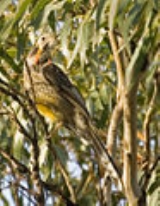The
Yellow Wattlebird is a species of
birdBirds are feathered, winged, bipedal, endothermic , egg-laying, vertebrate animals. Around 10,000 living species and 188 families makes them the most speciose class of tetrapod vertebrates. They inhabit ecosystems across the globe, from the Arctic to the Antarctic. Extant birds range in size from...
in the Meliphagidae family.
9 Other names include the Long or Tasmanian Wattlebird.
2
Description
The yellow wattlebird is the largest of the honeyeaters
5 and is endemic to Tasmania Australia. They are usually 375-450mm long.
2 They are named for the wattles in the corners of their mouths.
2 Yellow wattlebirds are slim birds with a short, strong bill.
7 They are dark coloured forest birds that somewhat resemble slandering Grackles.
2 They have a white face and black streaked crown.
5 They also have a long, pendulous yellow-orange wattle.
5 The wattle becomes brighter during breeding.
7 They have dark wings and a yellow belly
5 whereas the upperparts are grey to dusky brown.
2 The female yellow wattlebird is much smaller than the male.
5 The young yellow wattlebirds have much smaller wattles, a paler head and a browner underbelly than the adult birds.
7 Yellow wattlebirds are active and acrobatic with a strong flight.
2 They are fairly tame birds and often enter gardens looking for food.
2
Voice
Harsh, raucous, often been compared to a person coughing or vomiting
2. Click the link to listen to the call of the yellow wattlebird
http://www.parks.tas.gov.au/wildlife/birds/yellow_wattlebird.AIFF (Clip taken from Parks and Wildlife Service Tasmania)
8
Breeding
Yellow wattlebirds nest in breeding pairs and aggressively defend their territories from other birds.
7 The nest of the yellow wattlebird is made by the female alone
7 and is a large, open saucer-shaped structure made of twigs and bark that are bound by wool.
2 The inside of the nest is lined with wool and grass.
2 The nests can be up to 13 cm high and are found in trees or shrubs
2. Yellow wattlebirds lay 2-3 eggs that are salmon red, spotted and blotched red-brown, purplish red and blue-grey
2. Both the males and females incubate the egg and feed the young
7.
Habitat
Yellow wattlebirds live in a variety of habitats including both dry and wet forests and from sea level to the subalpine zone.
7 They live in coastal heaths, forests and gardens near eucalyptus trees.
5 They also can be found in mountain shrubberies and open woodlands, particularly those dominated with banksias.
2 They have also been known to be found on golf courses, orchards, parks and gardens.
2
Range
Yellow wattlebirds are common in Tasmania especially in the eastern and central areas.
7 They are also found on King Island and 2 sightings have been recorded on the South Mornington Peninsula in Victoria.
2
Ecology
Yellow wattlebirds feed on the nectar of eucalypts and banksias, fruit, insects, spiders, honeydew and manna.
6 They forage from all levels of the canopy from the ground to the top of the trees.
7 However, the blossoming of eucalyptus trees can be highly irregular in time and place causing considerable changes from year to year in the breeding distribution of yellow wattlebirds which rely on the nectar from the eucalyptus trees as a main source of food
4. Therefore, the most likely threat to the yellow wattlebird is unusual climatic conditions that can reduce food availability suddenly.
6 Also, it is important to note that yellow wattlebirds have been found to be pollinators of eucalyptus trees by carrying pollen in both their bills and head feathers.
1
The source of this article is
wikipedia, the free encyclopedia. The text of this article is licensed under the
GFDL.


